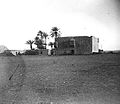Al-Midan
This article needs additional citations for verification. (May 2016) |
Al Midan
الميدان | |
|---|---|
Neighborhood | |
 Midan Souk - Jezmatieh Street | |
 | |
| Country | Syria |
| City | Damascus |

Coordinates: 33°29′N 36°17′E / 33.483°N 36.283°E Al-Midan (Arabic: حي الميدان) is a neighbourhood and municipality in Damascus, Syria, just south of the old walled city and very near the modern city centre. In the 2004 census, it had a population of 177,456.[1] Its streets and alleys are full of heritage and history due to the age of the neighbourhood. Throughout history, its people fought alongside their brothers from other neighbourhoods to protect Damascus. Also, there are many great Damascene scholars who were born here. Today, the neighbourhood is often considered to be one of the most conservative in Damascus.[citation needed]
Etymology[]
The name Midan is derived from Midan Al Hassa (Arabic: ميدان الحصى) or the field of gravel. The neighbourhood was located between two sub Barada streams and when it rained heavily, the land gravel deposits filled the streams and consequently, the neighbourhood.[2]
History[]

Al-Midan started during the Mamluk rule over Damascus. It took its final form about 400 years ago during the Ottoman empire and has not experienced any major changes since. It is considered the Southern Gate of Damascus and was created as a trading center by the people of Damascus for them to be closer to the people of the Hauran and to improve trade and economic relations between them.
During the French occupation, the people of this neighborhood fought fiercely for their freedom. The people of Midan revolted aggressively against the French and thus suffered heavy bombing during the Great Syrian Revolt of 1925–1927.[3] Their actions were driven in part by the extensive commercial links connecting the grain merchants of the neighborhood with Druze notables in the Hawran, among whom the revolt had begun.[4]
Michel Aflaq and Salah al-Din al-Bitar, the founders of the Ba'th Party, were both born in the Midan, the sons of grain merchants.
The neighborhood was and still is (compared to other neighbourhoods in Damascus) very conservative.

Cuisine[]
This section needs additional citations for verification. (May 2020) |
Midan is known throughout Syria and the surrounding countries for the delicious sweets it offers. Hundreds of years of cooking and making the best foods and sweets have made this neighborhood extremely famous. In fact, some of the stores that are based in this neighbourhood are now worldwide and are loved by everyone. Some examples of these stores are Daoud Brothers Sweets and Abu Haidar Sweets. Some of the sweets for which Midan is famous for Baklava, Barazek, Kanafeh, Namorah, Awameh.
Districts[]
This section does not cite any sources. (June 2020) |
- Bab Masr (pop. 11,330)
- Daqaq (pop. 10,858)
- Al-Haqleh (pop. 8,076)
- Al-Qa'a (pop. 11,791)
- Midan al-Wastani (pop. 23,745)
- Al-Tadamon (pop. 86,793)
- Az-Zahreh (pop. 24,863)
See also[]
References[]
- ^ "CBSSYR : Arab Republic Office Of Prime Minister". CBSSYR. Archived from the original on 1 August 2012.
- ^ "Discover Syria". www.discover-syria.com.
- ^ [1]
- ^ Provence, Michael (2005). The Great Syrian Revolt and the Rise of Arab Nationalism. Austin: University of Texas Press. pp. 13, 69.
- Neighborhoods of Damascus


